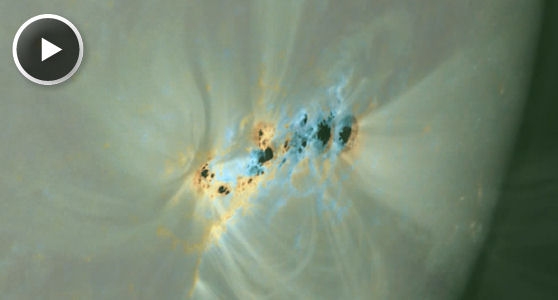Imagine forecasting a hurricane in Miami weeks before the storm was even a swirl of clouds off the coast of Africa—or predicting a tornado in Kansas from the flutter of a butterfly’s wing in Texas. These are the kind of forecasts meteorologists can only dream about.
Could the dream come true? A new study by Stanford researchers suggests that such forecasts may one day be possible—not on Earth, but on the sun.
“We have learned to detect sunspots before they are visible to the human eye,” says Stathis Ilonidis, a PhD student at Stanford University. “This could lead to significant advances in space weather forecasting.”
Sunspots are the “butterfly’s wings” of solar storms. Visible to the human eye as dark blemishes on the solar disk, sunspots are the starting points of explosive flares and coronal mass ejections (CMEs) that sometimes hit our planet 93 million miles away. Consequences range from Northern Lights to radio blackouts to power outages.
In the 19th August issue of Science, it was announced that they can see some sunspots while they are still submerged.
Submerged sunspots have a detectable effect on the sun’s inner acoustics—namely, sound waves travel faster through a sunspot than through the surrounding plasma. A big sunspot can leapfrog an acoustic wave by 12 to 16 seconds. “By measuring these time differences, we can find the hidden sunspot.”
The report says the technique seems to be most sensitive to sunspots located about 60,000 km beneath the sun’s surface. The team isn’t sure why that is “the magic distance,” but it’s a good distance because it gives them as much as two days advance notice that a spot is about to reach the surface.

Charles M0OXO
I was born in the 1960’s and have lived all my life in the Coal Mining Town of Barnsley in South Yorkshire, Northern England. My parents were all from this area of Yorkshire and my father worked in the main Industry of the local Collieries as a face worker. I have been married to my wife Debbie for 38 years and we have two children and two grandchildren.
I have been licensed for around 20 years after my interest was re-kindled when I retired from my role as a Police Officer within South Yorkshire Police Force. The latter few years were spent as Radio Operator in the Force Operations Control Room at Sheffield, before my career ended.
IOTA chasing is (and always has been) my real passion, as climbing the ladder to reach Honour Roll status was always my main aim. The 1000 Islands Trophy is still out of reach but I am heading in the right direction. I am currently a Board Member of IOTA Ltd.
In my free time I am a keen Photographer of Wildlife but the QSL Manager role is my main passion within Ham Radio.
https://www.m0oxo.com/
https://www.m0oxo.com/oqrs/
https://www.facebook.com/charles.wilmott.3

